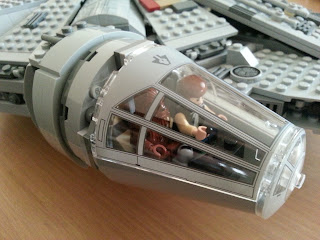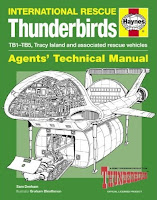A product of the 1950's, Dan Dare brought science fiction to a young generation looking for escapism in the post-war years.
Introducing a range of characters, enemies and beautifully conceived spacecraft through the Eagle comic the world of the near future looked bright and exciting.
Seeing as we're now on the other side of the period in which Dan Dare: Pilot of the Future was set, I can confirm that it's definitely fictional and at no time have I seen or heard of the Mekon existing nor have I recently been to the Marsport Museum. That won't stop fans from lapping up this new volume in the Haynes library: Dan Dare: Space Fleet Operations Manual.
With two feet firmly in the fictional universe aside from the introduction, this might not necessarily appeal to a massive science fiction audience it will attract readers of a certain age and those with an interest in comic history at the very least.
Now I'm not in any way saying this is a terrible book and should be avoided like the Crimson Death, but it is an acquired taste and very, very Anglo-centric. The characters we meet here are the very pinnacle of what it meant to be British in the 1950's and they are in turn accompanied and supported with a myriad of alien creatures well imagined by the writers over 60 years ago. The artwork is recreated in pristine fashion and you can see the influences of the period right the way through. The most evident is in the style and design of the ships that this manual covers so well.
Being almost a complete virgin to the world of Dan Dare I was worried I would be completely at sea and find this very difficult to get into. That wasn't the case as Rod Barzillay provides a great route into the universe through a detailed narrative section which tells the backstory of the first space missions, Moon and Mars landings as well as the science behind the ways in which these adventurers made their way to the stars. This more than adequately sets the scene for the world in which Dare exists and before you know it the page turns and you're confronted with the craft of the time. The shapes, colours and features of the Venture or Neptune Class ships are heavily indicative of the 1950's - lots of windows, bright colours, fins, wings and big rockets that would have mirrored the cinematic serials that were popular on both sides of the Atlantic and created more amazing worlds for the children of the time.
The illustrations from Graham Bleathman are new for this volume and explore every nook and cranny of the vast range of ships that were stars of the comic and inspired a generation. I did appreciate that these were also backed up with original snippets from the comics to show the action of the series and give you a visual point of reference. The fact that a lot of the cutaway drawings have over 50 points of interest keyed to them says a lot about how these were visualised at the time.
Just in case (like me) you have zero idea where each of the ships such as the Anastasia or the Marco Polo were featured then each vessel or space station or base is introduced with a small piece detailing its purpose and also an "ISF Data File" that explains where it was featured within the Dan Dare adventures. Instead of leaping out of context and relating these to the publications they are kept within the fictional universe. Only at the end of the book is there a section compiling where key incidents can be found in the comic and annuals produced.
The Space Fleet Operations Manual does cover a great deal in relation to the fleet craft as well as those of their allies, enemies and civilian craft that graced the pages of Eagle. One thing I did find a bit lacking was the personnel files especially when it came to Dare and the Mekon. Each are only given a few lines amidst the multitude of characters who were part of the stories and I would have appreciated a bit more space being given to the more key figures so I could get to know their significance and important moments. In regards to the cast, there were a lot and I did have to go back over them a few times to get their relationships and who did what, who was killed where and how that person was relevant to this situation. Some sort of diagram might've helped at this point but I think I got there in the end!
 Also, a note to Haynes that while the books are brilliantly produced and bound in glossy hard cover, some of the items keyed are lost in the centre of the book. Case in point here would be Tharl's Battleship which graces the back cover as well. The outer ring of this ship is a big part of its design but because of the way the pages are bound the centre hits right across this part of the ship and detracts from the experience. A real shame as I was massively impressed by how much detail is included on each of the pages. As you can see from the illustration here each page is well laid out and balanced to give a full overview of the vessel - some in colour, some black and white. On occasion some of the lesser craft (and creatures) are condensed into sections such as those covering Threen or Theron craft later in the manual. Some might think that this could be a negative however keeping themanual focused on the more prominent ships az well as paying minor dues to also seens ensures that the whole of the Dsn Dare story is covered. Notably it is smaller ships that are picutured and not cutaway so I dont think there is much being missed.
Also, a note to Haynes that while the books are brilliantly produced and bound in glossy hard cover, some of the items keyed are lost in the centre of the book. Case in point here would be Tharl's Battleship which graces the back cover as well. The outer ring of this ship is a big part of its design but because of the way the pages are bound the centre hits right across this part of the ship and detracts from the experience. A real shame as I was massively impressed by how much detail is included on each of the pages. As you can see from the illustration here each page is well laid out and balanced to give a full overview of the vessel - some in colour, some black and white. On occasion some of the lesser craft (and creatures) are condensed into sections such as those covering Threen or Theron craft later in the manual. Some might think that this could be a negative however keeping themanual focused on the more prominent ships az well as paying minor dues to also seens ensures that the whole of the Dsn Dare story is covered. Notably it is smaller ships that are picutured and not cutaway so I dont think there is much being missed.
It's definitely a book for those of a certain taste and perhaps a certain age who remember Dan Dare: Pilot of the Future from their youth and days spent reading his battles with the Mekon and other alien races. For sci-fi enthusiasts it will provide a great chance to see how writers and illustrators believed things might turn out in the near future. It's strange to think that this was how the 1950's throught the 1970's through to the present would turn out. According to Dan Dare we should have colonised the Moon, Mars and one or two asteroids as well as being able to travel to the edge of the solar system all through an alliance of the UK, USA and France - what happened there?! The optimism is almost as overwhelming as the now retro illustrations. In comparison the cutaways do retain a crispness that marks them out as new but their external colouring has managed to be planted firmly back in the creative world of the 1950's.
 As a segment of history on another hand it's absolutely priceless. A way to view the attitude of the post-war generation, their optimism, their search for a hero and their desire to literally reach for the stars. For those with a passing interest it might be a bit of an overload unless you are considering reading the adventures of Dan Dare yourself in the near future. Existing and long time fans will not be disappointed as there is nothing to bring dislike here and the manual will add one more level of technical reference to your Space Fleet library. The hopes of an age burst from opulence and magnificence of the grandiose space concepts on each page and beam from the faces of the heroes sent out into the great vacuum to save the Earth and explore the solar system.
As a segment of history on another hand it's absolutely priceless. A way to view the attitude of the post-war generation, their optimism, their search for a hero and their desire to literally reach for the stars. For those with a passing interest it might be a bit of an overload unless you are considering reading the adventures of Dan Dare yourself in the near future. Existing and long time fans will not be disappointed as there is nothing to bring dislike here and the manual will add one more level of technical reference to your Space Fleet library. The hopes of an age burst from opulence and magnificence of the grandiose space concepts on each page and beam from the faces of the heroes sent out into the great vacuum to save the Earth and explore the solar system. This might have been a creation of my father's time as a boy but it was entertaining nonetheless It makes you realise how easy current youngsters have it - do they have such strong, moral, law abiding role models to aspire and look up to? Maybe this is an avenue to showing the kids or grand-kids that there's more to life than waiting for the launch of the PS4, X Box 1 or the next big computer game - open a book, start with this one.
Dan Dare: Pilot of the Future: Space Fleet Operations Manual is available now from Haynes Publishing priced £16.99 ISBN 9780857332868











































